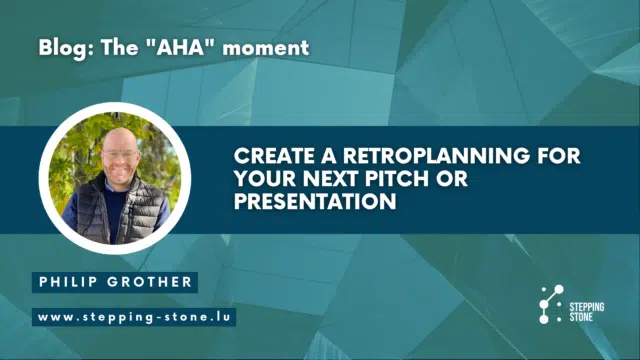Here’s a step-by-step process for you to create your retroplanning for the next time you have a public speaking engagement:
Step 1
- Work backwards from the date of your public speaking engagement
- The more time you have, the less excuses you have for not being prepared
Step 2
- Set yourself regular appointments with yourself
- These are non-negotiable and you make sure that you will not be interrupted
- For example: If you have 2 weeks before the presentation, spending 1h/working day will mean that you give yourself 10h of dedicated time to prepare and practice your presentation
- The more intentional time you spend preparing for a pitch, the less you will stress about it, and the better you will feel about giving the presentation
Step 3
- Know your audience
- Understanding your audience means that you will be able to adapt your pitch and narrative to their wants and needs
- Your presentation isn’t about you, it’s about your audience
- The more you adapt your pitch and narrative to your audience, the more engaged they will be and the more impact you will have on them
Step 4
- Be clear on the objective of your presentation
- Starting with the end in mind allows you to be clear about what message you want and need to get across to your audience
- You can’t be everything to everyone, or you won’t be anything to anyone, so don’t try to present everything, only that which truly matters to your audience
Step 5
- Focus on delivering key concepts
- Keep it super simple
- Don’t hesitate to state what you feel is blindingly obvious, because that might be the key an “AHA!” moment further down the line
Step 6
- Build your narrative around the key concepts and your audience
- Tell your audience a story
- Take them on a journey
- Don’t just give them a shopping list of facts and figures
Step 7
- Highlight the “AHA!” moments you want your audience to have
- An “AHA!” moment is that key moment of understanding that allows your audience to “get it”
- An “AHA!” moment creates more engagement that anything else, because your audience wants to feel intelligent
- The main reason why an audience is disengaged is because they have lost the will to understand, and nothing triggers that better than feeling dumb and lost
Step 8
- Prepare your narrative to get your audience to use their imagination
- By using their imagination, your audience creates an emotional bond with your story and they are more likely to stay engaged throughout the pitch
- Using images and analogies allows the audience to create mental shortcuts and associations
- Make sure you guide your audience in the creation of mental images, because you don’t want them to go off on a mental tangent and misunderstand the point that you are putting across
Step 9
- Build a strong introduction
- You could ask “Why is this step 9 in the process?!”
- Whilst you have been building all of the above, you will undoubtedly have come across an introduction that is going to be impactful for the audience for whom your are building this particular pitch
Step 10
- Conclude your pitch with a clear call to action
- Your audience needs to know what they need to do when you have finished
- For for example, if you are raising funds:
- “To set up a one-on-one meeting with me and my team to talk about your investment in our venture, send me an email on [email protected]”, or
- “To access our data room, please scan the QR code on the screen or go to www.mycompany.com/dataroom and use the password myname1!”.
- If you are not fundraising, the same logic applies:
- “To sign-up for ABC, go to www.mycompany.com and click on XYZ button”, or
- “To help us achieve ABC objective, like and share XYZ content on www.socialmedia.com”.
Step 11
- Build your pitch deck with as few words on the slides as possible
- If possible only use visual
- Words on the slides will be read by your audience and they won’t listen to you
- Click here to find out about The 13 key sections of a fundraising pitch
Step 12
- Record yourself – audio
- Listen to:
- the clarity of the content of your pitch
- your pronunciation and articulation
- your language and verbal tics
- the “AHA!” moments
- the silences
- your speed and cadence
- Listen to:
Step 13
- Record yourself – video
- Look at:
- your stage presence
- your use of your hands for punctuation
- your non-verbal communication
- your involuntary movements
- your posture
- Look at:
Step 14
- Overcome your hatred of hearing your own recorded voice
- Read this article: Why you hate listening to your recorded voice
Step 15
- Practice your breathing
- The 3×5 technique:
- Breath in counting to 5 as slowly as possible
- Breath out counting to 5 as slowly as possible
- Do this for 5 minutes as regularly as possible – not just before speaking in public
- This will increase the amount of oxygen in your blood, which will slow your heartbeat down and allow you think clearer
- Having a slower heartbeat and increased mental clarity will decrease your stress levels, meaning that you will perform better
- The 3×5 technique:
Step 16
- Practice in front of an audience
- Organise multiple dry runs with an audience
- Ask for feedback and listen open-mindedly
- The more your practice in public, the easier it will become
Step 17
- Practice your Q&A
- If your pitch has a Q&A session, write all the questions you think the audience might have and practice answering them
- Do this during your dry runs
- In your list of questions, include the ones you don’t want your audience to ask
Bonus Step
-
- If you have a public speaking engagement of any kind, and you want to be as prepared as possible, contact Philip Grother via this contact form or book a call.


